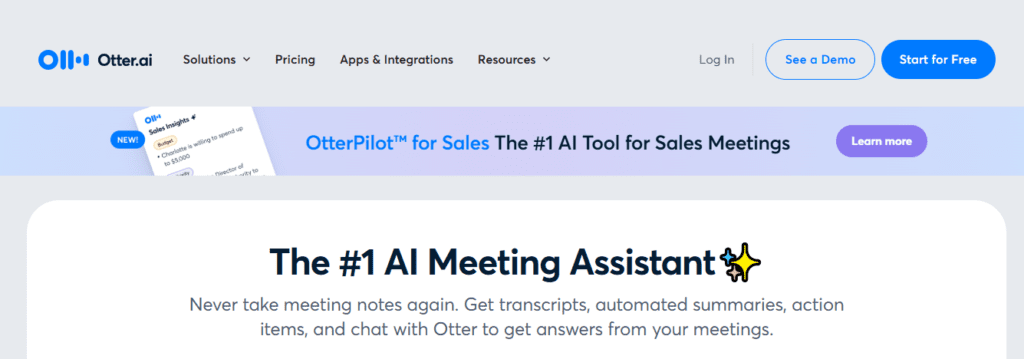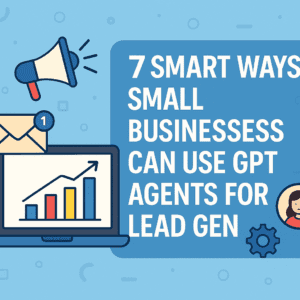Running a startup is no easy feat. You’re juggling a million things at once: managing teams, pleasing customers, balancing budgets, and planning growth.
But what if you could automate a significant chunk of your daily tasks? That’s where AI tools come in.
There are a number of AI tools you can integrate into your business processes. This way you can streamline operations, make smarter decisions, and focus on what really matters—growing your business.
Think about the hours you spend each week on repetitive tasks like scheduling, data entry, or responding to basic customer inquiries. AI can tackle these mundane tasks for you, leaving you free to focus on strategy and innovation.
Automation can literally save up to 20-30% of your business’s time on routine tasks. Imagine what your startup could achieve with that extra time.
Here are practical ways AI can transform your startup’s productivity:
1. Automate Routine Tasks
Repetitive tasks can eat up hours of your day. Instead of manually handling tasks like data entry or inventory management, you can allow AI to do the heavy lifting.
For instance, AI tools like Zapier can automate workflows by connecting apps you already use. Imagine automatically updating your inventory when a sale is made or organizing customer feedback into actionable insights—just from a one time setup.
With Zapier, you can set up custom workflows to streamline processes unique to your business. For example, when a customer submits a support ticket, Zapier can automatically create a task in your project management tool, notify the relevant team members, and even update your CRM.
AI can also be useful in customer support. Using AI-powered chatbots like ChatGPT or Zendesk, your business can handle inquiries 24/7. Customers no longer wait for responses, and you’re not tied up answering repetitive questions.
Why It Matters: According to a study by Salesforce, 69% of customers prefer chatbots for quick communication, and businesses report a 64% reduction in response times when chatbots are implemented. By integrating these tools, you’re improving customer satisfaction and freeing up valuable time for strategic tasks.
Pro Tip: Customize your chatbot’s responses to reflect your brand’s voice and integrate it with platforms like Facebook Messenger, WhatsApp, or your website to provide seamless support across channels.
2. Easy Meeting Scheduling and Organizing
Scheduling meetings can be an operational nightmare, especially when you’re working across different time zones or dealing with packed calendars.
Now, there are different AI scheduling assistants like Calendly or x.ai available to help you handle these issues easily. These tools analyze everyone’s availability in real time and suggest meeting slots that work for all participants, saving you from endless back-and-forth emails.
Imagine this: You’ve got an urgent meeting to plan with your team and a key client. Instead of manually coordinating schedules, you set up an AI scheduler to scan everyone’s calendar. Within seconds, it identifies a common slot and sends out invites. Even better, if something comes up, the AI can automatically reschedule based on updated availability, ensuring you don’t waste precious time.
Why It Matters: Study by McKinsey shows that businesses adopting AI scheduling tools have seen a 20% increase in team productivity. This isn’t just convenience; it’s a game-changer for your business. By reducing scheduling conflicts and optimizing everyone’s time, you can keep your operations running smoothly while focusing on growth.
Practical Tip: Integrate an AI scheduler with your team’s calendar to block focus time for deep work. For example, when deadlines are looming, the scheduler can reschedule non-urgent meetings to less critical hours, giving you uninterrupted time to tackle high-priority tasks.
3. Take Notes and Summarize Meetings
Your team’s next big idea might come from your meetings—but only if someone captures it. AI transcription tools like Otter.ai can record meetings, transcribe conversations in real time, and generate concise summaries. This allows everyone to stay fully engaged during discussions without worrying about missing critical points.

How It Works: While having conversations during meetings, instead of jotting down notes, you let Otter.ai handle it. The tool identifies speakers, captures every detail, and organizes the conversation into a searchable transcript. After the meeting, it produces a clear summary highlighting action items, follow-ups, and key points. You’re now able to immediately share this with your team, ensuring no time is wasted.
Why It Matters: According to a study by the Harvard Business Review, ineffective meetings cost businesses up to $37 billion annually. By using AI to streamline your meetings, you’re not just saving time—you’re ensuring that every meeting contributes value to your business.
Practical Tip: Integrate Otter.ai with tools like Zoom or Microsoft Teams so your transcriptions and summaries are automatically saved in your project management software, such as Asana or Trello. This keeps your team aligned and ready to execute plans without manual tracking.
4. Write Faster and Better
Whether you’re crafting marketing campaigns, writing blog posts, or pitching to investors, writing can be time-consuming. AI writing assistants like Grammarly or Jasper have been incredibly useful for different businesses in creating polished, professional content faster.
Here’s how you can make the most of these tools:
· Refine Your Drafts: Paste your draft into Grammarly, and it’ll instantly highlight grammar mistakes, suggest rephrasing for clarity, and ensure your tone matches your audience. For example, if you’re writing an investor pitch, Grammarly can recommend a confident and professional tone, helping you make a stronger impression.
· Expand Your Ideas: Stuck on how to elaborate on a key point? Feed your main idea into Jasper, and watch it generate multiple suggestions to expand on your thoughts. For instance, if you’re drafting a blog post on startup growth, Jasper can suggest subtopics like “funding strategies” or “team building tips” and even write detailed paragraphs for you.
· Create Multiple Headlines: Need a headline that grabs attention? Jasper’s AI can produce 10 alternative options in seconds, giving you choices for A/B testing. Headlines are crucial for click-through rates, and using AI can increase your chances of finding the perfect one.
· Boost Productivity with Templates: Jasper offers pre-built templates for emails, ad copy, and social media posts. This means you don’t have to start from scratch. For instance, if you’re running a Facebook ad campaign, Jasper’s ad copy template can help you write engaging posts that convert.
Why It Matters: Grammarly users report an average productivity boost of 28%. According to a 2022 Grammarly study, businesses using the tool also see a 76% improvement in writing quality and a 60% reduction in time spent on editing. Imagine what this could mean for your startup when you’re juggling multiple writing tasks at once.
By integrating these tools into your workflow, you’re not just speeding up the writing process—you’re ensuring the content you produce resonates with your audience and drives results.
5. Simplifying Your Research Process
Research is essential but time-consuming. From scouring the internet for reliable sources, combing through lengthy reports, and piecing everything together. It can be a lot sometimes.
AI tools like Scite or ResearchRabbit can change that by doing the heavy lifting for you.
These tools sift through thousands of academic papers, market reports, and industry trends in minutes, compiling relevant insights that directly apply to your business. Imagine searching for user preferences in your niche—instead of spending weeks, you get a curated summary within hours.
Why It Matters: Businesses that leverage AI-driven research tools are 50% more likely to identify untapped market opportunities than those relying on traditional methods according to Mc Kinsey. Additionally, startups using AI research save an average of 5 hours per week on information gathering, freeing up more time for critical decision-making.
Practical Tip: Let’s say you’re planning to launch a new product. You can input keywords like “customer behavior” or “trends in mobile apps” into ResearchRabbit. Within minutes, it identifies emerging trends, giving you actionable insights. You can also track how these trends have evolved over time to refine your strategy.
6. Manage Your Emails with Ease
Emails can dominate your day, consuming an average of 4.1 hours daily, according to a McKinsey report. That’s over 20 hours per week you could spend growing your business instead of sorting through emails. AI-powered tools like SaneBox or Superhuman transform the way you handle your inbox, ensuring that important emails never slip through the cracks.
Here’s how you can take control of your inbox:
- Sort Emails Automatically: Use SaneBox to create smart filters. For example, you can direct customer inquiries to a “Client Requests” folder, partnership opportunities to “Business Development,” and team updates to “Internal Communications.” This helps you prioritize and find critical emails quickly.
- Prioritize with AI: Superhuman highlights urgent emails and deprioritizes less critical ones. Imagine being able to glance at your inbox and instantly know what requires your attention.
- Draft Responses Faster: Superhuman’s AI features can draft quick replies for routine inquiries. For example, if a potential partner asks about your services, the AI can generate a polite, informative response based on your previous emails.
- Stay Focused: Turn on features like “Inbox Pause” to batch your email checks, helping you avoid constant distractions. This way, you can dedicate focused blocks of time to responding instead of being reactive all day.
Why It Matters: Businesses using AI-powered email management tools report a 30% reduction in email processing time (Gartner, 2023). Think about the hours you could reclaim for strategy and innovation.
Practical Tip: Imagine you’re launching a new product, and customer emails flood your inbox. Instead of manually sorting and replying to each one, SaneBox automatically files feedback into a “Launch Feedback” folder, highlights investor questions in your priority inbox, and queues marketing collaborations for later review. You save hours and ensure every stakeholder feels valued.
7. Generating Fresh Ideas
AI can also help you brainstorm solutions that resonate with your business needs. Tools like ChatGPT don’t just generate generic ideas—they tailor suggestions to your input, saving you from staring at a blank screen.
Here’s How You Can Use It: Imagine you’re planning a product launch. Input the basic details into ChatGPT—your target audience, goals, and even your budget—and let it churn out ideas. For instance, you might receive 10 actionable content strategies, from crafting behind-the-scenes videos to running interactive social media polls.
Want something more tailored? Ask ChatGPT to generate customer-focused campaigns based on real-time trends. For example, if your startup targets Gen Z, it might suggest leveraging TikTok trends or creating Instagram Reels that align with their interests.
Why It Matters: According to McKinsey, companies that integrate AI into their creative workflows are 25% more likely to achieve faster time-to-market. Your business can tap into this advantage, using AI to streamline brainstorming sessions and unlock innovative opportunities.
8. Optimize Your Team’s Schedule
AI tools do not only make your life easier; it’s about making your team’s workday more productive and less stressful. Tools like Clockwise analyze your team’s work patterns to identify peak productivity times. They don’t just guess—they use hard data from your team’s calendar activity to recommend changes that maximize deep work and collaboration.
Clockwise can automatically block out focus time in your team’s calendar, ensuring everyone has uninterrupted periods to tackle critical tasks. It even reschedules non-essential meetings to quieter times of the day.
Why It Matters: According to a study by RescueTime, workers spend an average of just 2 hours and 48 minutes being productive each day. Tools like Clockwise help you reclaim lost hours, turning unproductive time into high-value work.
Pro Tip: Pair Clockwise with your task management tool to align your schedule with your goals. For example, if your startup uses Asana or ClickUp, Clockwise can ensure that your highest-priority tasks are front and center during your most productive hours.
9. Effective Language Translation
If your startup operates globally, communication challenges can slow you down. With AI-powered translation tools, you can bridge those gaps effortlessly. Tools like DeepL and Google Translate provide real-time translations that are surprisingly accurate and context-aware.
Imagine you’re presenting a product demo to a potential client in another country. Instead of stumbling over language barriers, you use DeepL to translate technical terms and key points into their native language. You’re not just communicating—you’re showing respect for their culture and making your message crystal clear.
Why It Matters: According to CSA Research, 76% of online shoppers prefer to buy products in their native language, and businesses that invest in localization see a 1.5x boost in customer engagement. Your startup can tap into this potential by ensuring your communications resonate with global audiences.
Pro Tip: Pair AI translation tools with voice recognition apps like Sonix for multilingual meetings. This ensures that both spoken and written content are accurately translated and culturally appropriate.
10. Gain Actionable Insights from Data
Your business generates data every day. Whether it’s customer behavior, sales performance, or website traffic, every piece of data holds valuable insights—but only if you know how to analyze it. Tools like Tableau or Power BI make it easy to turn raw data into actionable intelligence that drives results.
Imagine you are running multiple marketing campaigns across different platforms. With Tableau, you can quickly visualize which channels are driving the most conversions. You’ll see that your paid ads on Instagram are bringing in three times the ROI of your email campaigns. Instead of wasting time and money, you reallocate your budget to double down on Instagram ads, boosting your revenue without increasing costs.
Why It Matters: According to a McKinsey report, companies that use AI for data-driven decision-making see productivity improvements of 20-30%. For startups, this could mean identifying trends faster, optimizing resources, and gaining a competitive edge.
By leveraging AI tools to analyze your data, you can uncover patterns and opportunities you might otherwise miss. Whether it’s predicting customer trends, identifying inefficiencies, or flagging potential risks, AI turns your data into a powerhouse of insights for smarter decision-making.
Wrapping Up
Your goal for incorporating AI into your startup shouldn’t be about keeping up with trends; it’s about giving your business a competitive edge. You don’t need to overhaul everything at once—start small. Choose one or two tools that align with your most pressing needs, and scale up as you see results.
For example, you could implement a scheduling assistant to streamline meetings or use an AI-powered email manager to declutter your inbox.
Focus on how AI can empower you and your team. Instead of spending hours manually compiling reports, use predictive analytics tools to uncover trends and make better decisions. Delegate repetitive tasks to AI, freeing your team to innovate and solve complex problems. Imagine spending less time on administrative work and more time brainstorming your next big product or refining your customer experience.
AI isn’t here to replace you—it’s here to make you better. It’s like having a tireless assistant who never sleeps and constantly learns. So you can start experimenting with these AI tools and watch how they transform your startup’s efficiency and potential for growth.










